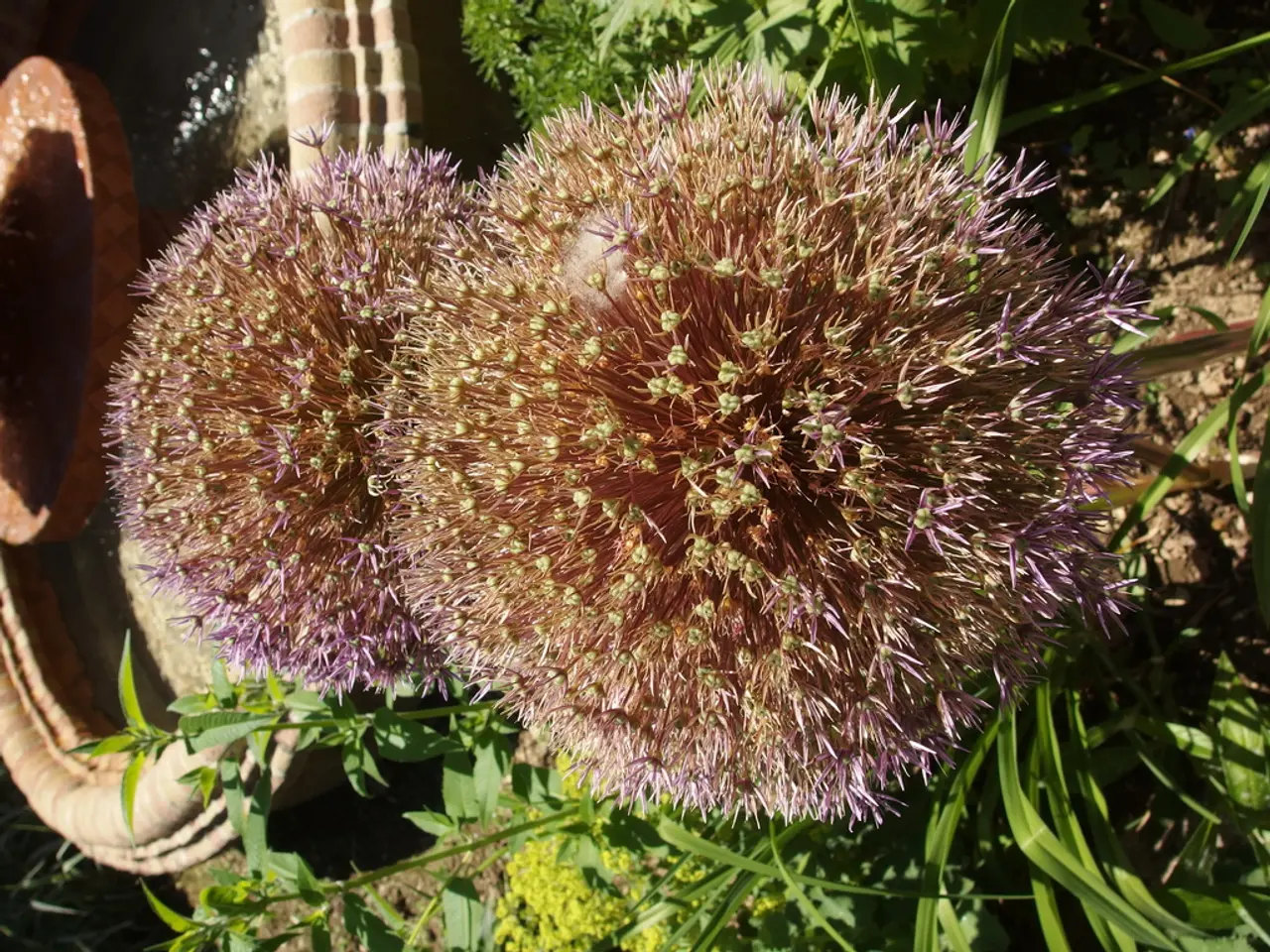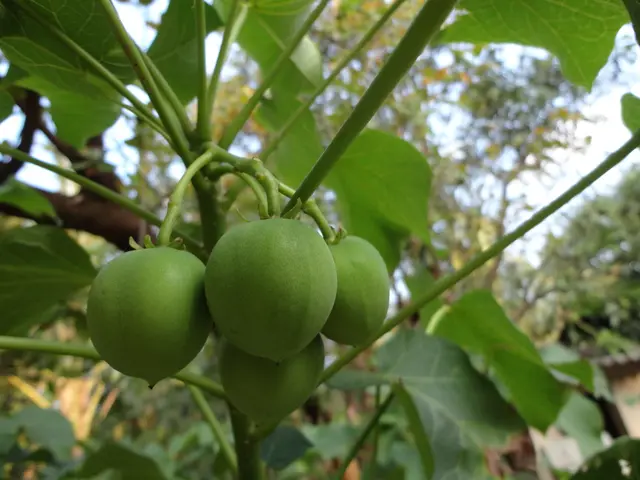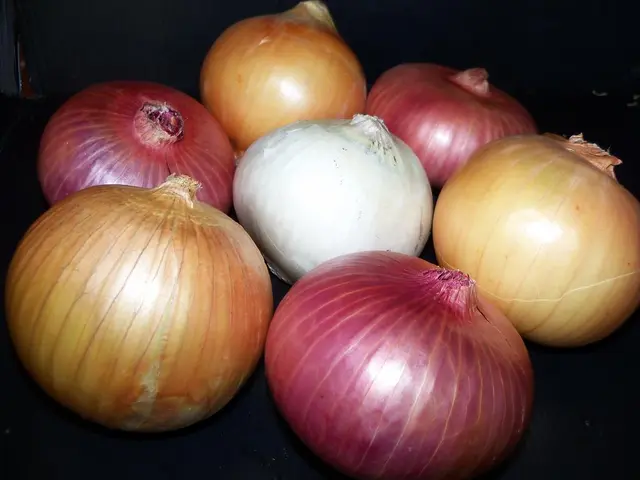Expert Gardener Shares 7 Strategies for Minimizing Water Use in the Garden During Heatwaves, Resulting in Time and Resource Savings
Keeping your garden looking lush and green is a must, but it can be a real pain to water it, especially during those sweltering summer months. But fear not, my green-fingered friend! I've got some expert tips to help you conserve water and save time without sacrificing your garden's beauty.
Let's Get Mulchy
Wrapping your garden like a cozy blanket, mulching can help in more ways than one. It not only suppresses weeds but also improves soil quality and increases moisture retention. Organic mulches, such as garden compost or leaf mold, can reduce water evaporation from the soil surface and improve soil structure as they break down.[1] A thick layer of about 2 to 3 inches is ideal but remember to keep a small space around the plants to avoid rot.[2] If you've got a light and sandy soil like I used to, don't worry! Mediterranean plants love a free-draining soil and require less frequent irrigation.[3] However, if you want to improve your soil's water-retaining capabilities, chuck in plenty of organic matter to keep any moisture in check!
The Right Plant in the Right Place
The term "right plant, right place" was popularized by the gardener Beth Chatto back in the 1960s. It taught us the importance of considering a plant's ideal growing conditions. Over the years, I've learned that moving a struggling plant to a more suitable spot can make all the difference. With climate change on the rise, it's smart to think ahead and embrace climate-resilient planting. For example, by planting only sun-loving or drought-tolerant plants in a south-facing or hot border, you'll not only give the plants what they need but also reduce the need for constant watering once they're established.[4]
Making the Most of Containers
Containers can create a stunning visual display, but they do need more frequent watering than plants grown in soil. This is because there's only so much moisture a pot's soil can hold at any one time, especially in small pots.[5] I've found that grouping pots together can help reduce the need for watering, as they provide shade for each other and raise the humidity levels in their vicinity. For a permanent pot display, consider using a drip-emitting irrigation system, such as this one from Amazon, that's connected to an outdoor spigot. For containers in hard-to-reach places, water-storing crystals like these from Amazon can be a lifesaver. They swell and release moisture back into the soil when needed, making it easier to keep your plants hydrated.
Installing an Irrigation System
Managing large gardens can be time-consuming, but an irrigation system can save you both time and water. Drip irrigation systems and soaker hoses are popular choices, as they deliver water slowly and precisely to plant roots, reducing mildew risks and soil runoff.[1] An irrigation system can be set up with a timer to turn on only when needed and when evaporation is least likely, further conserving water. Suitable for newly laid hedging, borders, and vegetable patches, irrigation systems can also be highly beneficial when installed in a greenhouse or poly tunnel.
Harvesting Your Rainwater
Water is a precious resource, and rainwater harvesting is both eco-friendly and frugal. From rain barrels and water butts to extensive household greywater systems, there are numerous ways to collect rainwater for use in your garden.[6] Simple setups, like recycled plastic barrels linked to drain pipes, can be just as effective as more purpose-built systems. And don't forget about style! Here's a 50-gallon rain barrel from Amazon that not only does its job but looks good doing it.
Watering at the Right Time of Day
Watering in the cool of the morning before the day has started to warm up is the most efficient way to keep your garden hydrated. By doing this, you'll minimize evaporation and prevent mildew risks. If your schedule doesn't allow for early-morning watering, consider investing in a timer like this one from Amazon to ensure your plants are getting watered while you focus on other things.
Watering When the Plants Need It
Watering based on the weather forecast and soil conditions is key to conserving water. The weather forecast will give you an idea of how much supplemental irrigation you'll need, and checking the soil will tell you if it's still moist or if it needs a drink.[3] Remember, watering onto already saturated soil may lead to root rot, so be careful.
Wrapping Up
So there you have it, my dear green thumb pals! With these techniques, you can reduce the need for watering your garden and conserve this precious resource. Mulching, climate-resilient planting, taking care of containers, efficient irrigation systems, rainwater harvesting, watering at the right time of day, and watering when plants need it will help you maintain a beautiful garden while being a responsible water user. And who knows, with all the money you save on water bills, perhaps you can invest in a pint or two at the local watering hole.[7] Cheers!
Enrichment Data:
Effective water-saving techniques for gardening include several strategies such as mulching, climate-resilient planting, container gardening, efficient irrigation systems, rainwater harvesting, and watering at the right time of day. Here's a detailed summary based on expert recommendations and practical advice:
Mulching
- Applying a layer of organic mulch like straw, wood chips, or shredded leaves around plants helps conserve water by insulating soil and reducing evaporation by up to 70%. Mulch also suppresses weeds and keeps roots cooler, which improves soil moisture retention after watering compared to bare soil.[1][2]
- Experts suggest applying a 2 to 3 inch layer of organic mulch around plants for best results[2]
Climate-Resilient Planting
- Following the "right plant, right place" principle helps reduce water needs by choosing drought-tolerant or native plant species adapted to local climate conditions.[3] These plants require less supplemental watering and thrive better in the region's typical weather.
Container Gardening
- Container gardens can be managed efficiently by controlling soil moisture effectively and reducing water wastage. Containers can also be tailored with appropriate soil mixes that retain moisture well, further cutting down water use[3]
Efficient Irrigation Systems
- Drip irrigation is highly water-efficient because it delivers water directly to the plant roots under the mulch layer, minimizing evaporation and runoff. This targeted watering system is especially effective for planting beds and individual plants.[1][4]
- Soaker hoses release water slowly and evenly at the base of plants, which conserves water better than traditional sprinklers. They work best at low water pressure and can be customized to garden layouts.[1][4]
- Multi-stream rotating nozzles on sprinkler systems provide larger water droplets at slower rates, reducing evaporation and runoff, and improving uniform water distribution.[4]
- Smart irrigation controllers with soil moisture sensors can further save water by watering only when needed and adjusting schedules based on weather conditions, potentially saving 30% to 50% of water.[1]
Rainwater Harvesting
- Collecting and storing rainwater for garden use reduces dependence on municipal water and provides a free, natural irrigation source.[3]
Summary of Key Practices
- Mulch with 2-3 inches of organic material to keep soil moist longer.
- Choose climate-adapted plants to reduce supplemental watering.
- Use containers wisely to control moisture efficiently.
- Install drip irrigation or soaker hoses to target water application.
- Consider smart irrigation systems with sensors for optimal watering.
- Harvest rainwater to supplement irrigation needs.
- Water early morning or late evening to minimize evaporation.
These combined techniques enable gardeners to reduce water usage significantly while maintaining healthy and resilient plants[1][2][3][4].
[1] Mulching Oil & Vinegar Soap Co. "Mulch Your Garden for Conserving Water." Blog. Mulch Oil & Vinegar Soap Co., 2021. Web. 18 Nov 2021. [2] Garden Myths. "Mulching Benefits: Pros, Cons, and Best Mulching Practices." Garden Myths, 2021. Web. 18 Nov 2021. [3] Watersmartlandscaping.com.au. "Water Conservation for Your Garden: 14 Tips to Reduce Water Use." WaterSmart Landscapes, 2020. Web. 18 Nov 2021. [4] Waterwise. "Conserving Water with Efficient Irrigation – Good Practices Guide for the Home Garden." Waterwise, 2019. Web. 18 Nov 2021. [5] Trugood, Fiona. "Container Gardening Without a Hose." National Gardening Association, n.d. Web. 18 Nov 2021. [6] Rainwaterlounge.com. "11 Benefits of a Rainwater Harvesting System." Rainwater Lounge, 2020. Web. 18 Nov 2021. [7] Wong, Larissa. "4 Water-Saving Solutions for Your Home Garden." This Old House, n.d. Web. 18 Nov 2021.
Greenhouses can be a fantastic addition to your home-and-garden lifestyle, offering year-round gardening opportunities. By implementing greenhouse-friendly water-saving techniques such as drip irrigation systems, you can easily conserve water while nurturing your plants.
Keeping your greenhouse's lifestyle balanced includes selecting the right plants for various conditions—drought-tolerant plants are particularly suitable for greenhouses, as they require less constant watering. Mediterranean plants, for example, thrive in free-draining soil and are a perfect choice for a greenhouse that aims to cut down on water consumption.








